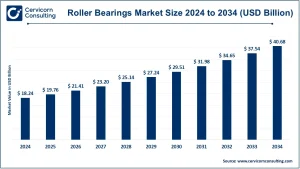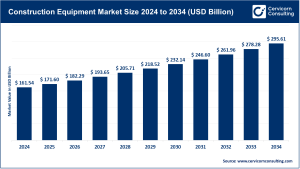Market Overview
The global electric compressor market is experiencing significant expansion, propelled by the growing adoption of energy-efficient and eco-friendly solutions across sectors such as automotive, manufacturing, construction, healthcare, and energy. The market was valued at USD 10.53 billion in 2024 and is expected to reach around USD 41.83 billion by 2034, reflecting a CAGR of 14.79% over the forecast period from 2025 to 2034.
Electric compressors utilize electric power to compress air or gases, offering advantages over conventional fuel-powered models, including reduced emissions, quieter operation, and enhanced energy efficiency. These benefits have led to their increasing preference in industrial automation and electric vehicle (EV) applications.
Get a Free Sample: https://www.cervicornconsulting.com/sample/2565
Key Market Trends
1. Industrial Electrification & Sustainability
Manufacturers are shifting from diesel and gas compressors to electric-driven alternatives to lower emissions and energy consumption. Modern smart factories are integrating electric compressors with IoT-based predictive maintenance systems, improving uptime and operational performance.
2. Automation & Smart Manufacturing
Integration of electric compressors into IoT networks and robotic systems enables real-time monitoring, predictive maintenance, and energy optimization. In 2024, nearly 25% of industrial electric compressors globally featured IoT or cloud diagnostic capabilities.
3. Rise of Portable Electric Tools
Battery-powered, compact compressors are increasingly used in construction, maintenance, and SMEs, providing mobility and convenience without sacrificing performance.
4. Adoption in Electric Vehicles (EVs)
Electric compressors play a critical role in EV air conditioning systems, representing about 80% of HVAC systems in Asian EVs and HEVs. Demand is expected to rise alongside the expanding global EV market.
5. Energy Efficiency Regulations
Around 48 countries have implemented standards for energy efficiency and emissions in compressors (e.g., ISO 1217, EU Ecodesign), pushing manufacturers to adopt energy-efficient electric systems.
Market Drivers
-
Rising Demand for Energy Efficiency: Variable-speed electric compressors can reduce energy consumption by up to 35% compared to conventional compressors, helping industries lower operational costs.
-
Growing EV Adoption: Expanding EV production fuels demand for automotive electric compressors, especially for cabin cooling and HVAC systems.
-
Technological Advancements: Smart compressors with IoT integration and variable-speed drives improve efficiency, reliability, and predictive maintenance.
-
Government Initiatives: Policies promoting industrial electrification and carbon footprint reduction incentivize the adoption of electric compressors.
Impact of Trends and Drivers
-
Regional Influence: North America accounted for 35% of the market share in 2024 due to industrial and energy sector demand, while Asia-Pacific is expected to grow fastest, driven by China’s EV market and industrial expansion.
-
Application Impact: Manufacturing, contributing 35% of market revenue in 2024, and automotive sectors benefit from energy savings and sustainability compliance.
-
Segmental Growth: Medium power compressors (20–100 kW) captured 45% of revenue in 2024, fueled by industrial automation requirements.
Challenges & Opportunities
Challenges: High upfront costs and integration complexity may limit adoption for small-scale operations.
Opportunities: Growing renewable energy infrastructure and increasing demand for smart, energy-efficient systems provide strong growth potential for electric compressor manufacturers.
Future Outlook
The electric compressor market is poised for strong growth, projected to exceed USD 41.83 billion by 2034, with a CAGR of 14.79%. Emerging trends such as EV integration, smart manufacturing, and portable compressors will continue to shape the market, presenting opportunities for both manufacturers and end-users seeking low-emission, energy-efficient solutions.
Source: Cervicorn Consulting

